Establishment of a Daqu Grade Classification Model Based on Computer Vision and Machine Learning
Abstract
1. Introduction
2. Materials and Methods
2.1. Sample Collection
2.2. Image Acquisition Method
2.3. Image Information Extraction
2.3.1. Image Segmentation
2.3.2. Selection of Regions of Interest
2.3.3. Image Feature Extraction
2.4. Construction of Image Classification Models
2.4.1. Feature Selection Methods
2.4.2. Model Construction Method
2.4.3. Model Evaluation Metrics
2.5. Environment Configuration and Data Partitioning
3. Results and Analysis
3.1. Daqu RGB Color Distribution Features
3.2. The Impact of Image Segmentation Methods on Image Classification
3.3. Performance Evaluation of Classification Models
3.3.1. Performance Evaluation of First-Layer Classification Models
3.3.2. Feature Selection Results for the Second Layer Classification
3.3.3. Performance Evaluation of the Second Stage Classification Model
3.4. Validation of the Model with Multiple Types of Daqu
4. Conclusions
Author Contributions
Funding
Institutional Review Board Statement
Informed Consent Statement
Data Availability Statement
Acknowledgments
Conflicts of Interest
References
- Wang, Y.; Cai, W.; Wang, W.; Shu, N.; Zhang, Z.; Hou, Q.; Shan, C.; Guo, Z. Analysis of microbial diversity and functional differences in different types of high-temperature Daqu. Food Sci. Nutr. 2021, 9, 1003–1016. [Google Scholar] [CrossRef]
- Zheng, X.-W.; Han, B.-Z. Baijiu, Chinese liquor: History, classification and manufacture. J. Ethn. Foods 2016, 3, 19–25. [Google Scholar] [CrossRef]
- Liu, H.; Sun, B. Effect of Fermentation Processing on the Flavor of Baijiu. J. Agric. Food Chem. 2018, 66, 5425–5432. [Google Scholar] [CrossRef] [PubMed]
- Deng, Y.; Huang, D.; Han, B.; Ning, X.; Yu, D.; Guo, H.; Zou, Y.; Jing, W.; Luo, H. Correlation: Between Autochthonous Microbial Diversity and Volatile Metabolites During the Fermentation of Nongxiang Daqu. Front. Microbiol. 2021, 12, 688981. [Google Scholar] [CrossRef]
- Hou, Q.; Wang, Y.; Qu, D.; Zhao, H.; Tian, L.; Zhou, J.; Liu, J.; Guo, Z. Microbial communities, functional, and flavor differences among three different-colored high-temperature Daqu: A comprehensive metagenomic, physicochemical, and electronic sensory analysis. Food Res. Int. 2024, 184, 114257. [Google Scholar] [CrossRef]
- Cai, W.; Wang, Y.; Ni, H.; Liu, Z.; Liu, J.; Zhong, J.A.; Hou, Q.; Shan, C.; Yang, X.; Guo, Z. Diversity of microbiota, microbial functions, and flavor in different types of low-temperature Daqu. Food Res. Int. 2021, 150, 110734. [Google Scholar] [CrossRef]
- Ding, L.; Zhao, M.; Zhao, X.; Chen, G.; Jiang, Q.; Liu, M.; Xiong, Y.; Zhang, X.; Wang, X.; Wei, Y.; et al. Evaluation of the spatial distribution and dynamic succession of microbial community and quality properties during fermentation in Chinese medium-temperature Daqu. J. Food Process. Preserv. 2022, 46, e17272. [Google Scholar] [CrossRef]
- Wang, H.Y.; Xu, Y. Effect of temperature on microbial composition of starter culture for Chinese light aroma style liquor fermentation. Lett. Appl. Microbiol. 2015, 60, 85–91. [Google Scholar] [CrossRef]
- He, G.; Huang, J.; Zhou, R.; Wu, C.; Jin, Y. Effect of Fortified Daqu on the Microbial Community and Flavor in Chinese Strong-Flavor Liquor Brewing Process. Front. Microbiol. 2019, 10, 56. [Google Scholar] [CrossRef]
- Xu, Y.; Sun, B.; Fan, G.; Teng, C.; Xiong, K.; Zhu, Y.; Li, J.; Li, X. The brewing process and microbial diversity of strong flavour Chinese spirits: A review. J. Inst. Brew. 2017, 123, 5–12. [Google Scholar] [CrossRef]
- Zheng, X.-W.; Tabrizi, M.R.; Nout, M.J.R.; Han, B.-Z. Daqu—A Traditional Chinese Liquor Fermentation Starter. J. Inst. Brew. 2011, 117, 82–90. [Google Scholar] [CrossRef]
- Zhang, Y.; Shen, Y.; Niu, J.; Ding, F.; Ren, Y.; Chen, X.; Han, B.-Z. Bacteria-induced amino acid metabolism involved in appearance characteristics of high-temperature Daqu. J. Sci. Food Agric. 2023, 103, 243–254. [Google Scholar] [CrossRef] [PubMed]
- Yuandi, Z.; Fang, D.; Yi, S.; Wei, C.; Yansong, X.; Beizhong, H.; Xiaoxue, C. Characteristics of the microbiota and metabolic profile of high-temperature Daqu with different grades. World J. Microbiol. Biotechnol. 2022, 38, 137. [Google Scholar]
- Di Rosa, A.R.; Leone, F.; Cheli, F.; Chiofalo, V. Fusion of electronic nose, electronic tongue and computer vision for animal source food authentication and quality assessment—A review. J. Food Eng. 2017, 210, 62–75. [Google Scholar] [CrossRef]
- Xu, M.; Wang, J.; Zhu, L. The qualitative and quantitative assessment of tea quality based on E-nose, E-tongue and E-eye combined with chemometrics. Food Chem. 2019, 289, 482–489. [Google Scholar] [CrossRef]
- Fan, G.; Sun, B.; Fu, Z.; Xia, Y.; Huang, M.; Xu, C.; Li, X. Analysis of Physicochemical Indices, Volatile Flavor Components, and Microbial Community of a Light-Flavor Daqu. J. Am. Soc. Brew. Chem. 2018, 76, 209–218. [Google Scholar] [CrossRef]
- Goni, S.M.; Salvadori, V.O. Color measurement: Comparison of colorimeter vs. computer vision system. J. Food Meas. Charact. 2017, 11, 538–547. [Google Scholar] [CrossRef]
- Weng, X.; Luan, X.; Kong, C.; Chang, Z.; Li, Y.; Zhang, S.; Al-Majeed, S.; Xiao, Y. A Comprehensive Method for Assessing Meat Freshness Using Fusing Electronic Nose, Computer Vision, and Artificial Tactile Technologies. J. Sens. 2020, 2020, 8838535. [Google Scholar] [CrossRef]
- Yang, H.I.; Min, S.G.; Yang, J.H.; Eun, J.B.; Chung, Y.B. A novel hybrid-view technique for accurate mass estimation of kimchi cabbage using computer vision. J. Food Eng. 2024, 378, 112126. [Google Scholar] [CrossRef]
- Bian, H.; Ma, B.; Yu, G.; Dong, F.; Li, Y.; Xu, Y.; Tan, H. Fusion features of microfluorescence hyperspectral imaging for qualitative detection of pesticide residues in Hami melon. Food Res. Int. 2024, 196, 115010. [Google Scholar] [CrossRef]
- Zeqing, Y.; Zhimeng, L.; Ning, H.; Mingxuan, Z.; Wenbo, Z.; Lingxiao, G.; Xiangyan, D.; Zhengpan, Q.; Shuyong, D. Multi-Index Grading Method for Pear Appearance Quality Based on Machine Vision. Agriculture 2023, 13, 290. [Google Scholar] [CrossRef]
- Kang, Z.; Fan, R.; Zhan, C.; Wu, Y.; Lin, Y.; Li, K.; Qing, R.; Xu, L. The Rapid Non-Destructive Differentiation of Different Varieties of Rice by Fluorescence Hyperspectral Technology Combined with Machine Learning. Molecules 2024, 29, 682. [Google Scholar] [CrossRef]
- Daniel, A.J.; Benjamin, S.; Maqsood, B.A.; Michael, F. Quality control of apples by means of convolutional neural networks—Comparison of bruise detection by color images and near-infrared images. Procedia CIRP 2021, 99, 290–294. [Google Scholar]
- Huang, Y.; Tian, J.; Yang, H.; Hu, X.; Han, L.; Fei, X.; He, K.; Liang, Y.; Xie, L.; Huang, D.; et al. Detection of wheat saccharification power and protein content using stacked models integrated with hyperspectral imaging. J. Sci. Food Agric. 2024, 104, 4145–4156. [Google Scholar] [CrossRef]
- Wang, C.; Xu, X.; Zhang, Y.; Cao, Z.; Ullah, I.; Zhang, Z.; Miao, M. A Stacking Ensemble Learning Model Combining a Crop Simulation Model with Machine Learning to Improve the Dry Matter Yield Estimation of Greenhouse Pakchoi. Agronomy 2024, 14, 1789. [Google Scholar] [CrossRef]
- Zhang, X.; Danping, H.; Jianping, T.; Dan, H. Research on the Daqu quality detection system based on machine vision. Food Mach. 2018, 34, 80–84. [Google Scholar]
- Li, J.; Jiaxiong, X.; Fenming, W.; Min, Z.; Xing, L. Discussion on the Physicochemical Properties of Fen Liquor Daqu During Storage. Liquor Mak. 2015, 42, 14–18. [Google Scholar]
- Ao, Z.; Xiaohu, S.; Caihong, S.; Defu, X.; Jianbo, R.; Zhiguo, H.; Xiaojun, W. Domestic Related Quality Standards of Daqu & Its Research Progress. Liquor.-Mak. Sci. Technol. 2010, 188, 104–108. [Google Scholar]
- Jiang, S.; Ni, C.; Chen, G.; Liu, Y. A novel data fusion strategy based on multiple intelligent sensory technologies and its application in the quality evaluation of Jinhua dry-cured hams. Sens. Actuators B-Chem. 2021, 344, 130324. [Google Scholar] [CrossRef]
- Kaushik, A.; Sheoran, K.; Kapur, R.; Bhutani, N.; Singh, B.; Sharma, H. SENSE: Software effort estimation using novel stacking ensemble learning. Innov. Syst. Softw. Eng. 2024, 1–17. [Google Scholar] [CrossRef]
- Han, J.; Yang, C.; Zhou, X.; Gui, W. A new multi-threshold image segmentation approach using state transition algorithm. Appl. Math. Model. 2017, 44, 588–601. [Google Scholar] [CrossRef]
- Jing, Z.; Tang, B. Improved image segmentation method based on Otsu thresholding and level set techniques. J. Phys. Conf. Ser. 2024, 2813, 012017. [Google Scholar] [CrossRef]
- Viswanathan, V.; Murugasamy, K. Modified ensemble machine learning-based plant leaf disease detection model with optimized K-Means clustering. Network 2024, 1–45. [Google Scholar] [CrossRef] [PubMed]
- Wenfei, Z.; Zhenzhou, W. An Approach of Separating the Overlapped Cells or Nuclei based on the Outer Canny Edges and Morphological Erosion. Cytom. Part A J. Int. Soc. Anal. Cytol. 2023, 105, 266–275. [Google Scholar]
- Maksimovic, V.; Jaksic, B.; Milosevic, M.; Todorovic, J.; Mosurovic, L. Comparative Analysis of Edge Detection Operators Using a Threshold Estimation Approach on Medical Noisy Images with Different Complexities. Sensors 2024, 25, 87. [Google Scholar] [CrossRef]
- Wang, B.; Chen, L.L.; Zhang, Z.Y. A novel method on the edge detection of infrared image. Optik 2019, 180, 610–614. [Google Scholar] [CrossRef]
- Xu, M.; Yang, S.-L.; Peng, W.; Liu, Y.-J.; Xie, D.-S.; Li, X.-Y.; Wu, C.-J. A Novel Method for the Discrimination of Semen Arecae and Its Processed Products by Using Computer Vision, Electronic Nose, and Electronic Tongue. Evid. Based Complement. Alternat. Med. 2015, 2015, 753942. [Google Scholar] [CrossRef]
- Wu, D.; Sun, D.-W. Colour measurements by computer vision for food quality control—A review. Trends Food Sci. Technol. 2013, 29, 5–20. [Google Scholar] [CrossRef]
- Vega, B.V.G.; Flores, C.M.; Navarro, C.S.G.; Vega, W.M.W.; Rodríguez, A.C.; Cano, L.a.R. Development of a Low-Cost Artificial Vision System as an Alternative for the Automatic Classification of Persian Lemon: Prototype Test Simulation. Foods 2023, 12, 3829. [Google Scholar] [CrossRef]
- Wang, H.; Sun, J.; Sun, J.; Wang, J. Using Random Forests to Select Optimal Input Variables for Short-Term Wind Speed Forecasting Models. Energies 2017, 10, 1522. [Google Scholar] [CrossRef]
- Mi, L.; Yifu, W.; Yunhong, X.; Lai, Z.; Jingjing, Q.; Siyu, Q.; Yujun, S. Combination of Feature Selection and CatBoost for Prediction: The First Application to the Estimation of Aboveground Biomass. Forests 2021, 12, 216. [Google Scholar] [CrossRef]
- Manivannan, G.S.; Mani, K.; Rajaguru, H.; Talawar, S.V. Detection of Alcoholic EEG signal using LASSO regression with metaheuristics algorithms based LSTM and enhanced artificial neural network classification algorithms. Sci. Rep. 2024, 14, 21437. [Google Scholar] [CrossRef] [PubMed]
- Milani, M.R.M.; Hense, A.; Rahmani, E.; Ploeger, A. Applying Least Absolute Shrinkage Selection Operator and Akaike Information Criterion Analysis to Find the Best Multiple Linear Regression Models between Climate Indices and Components of Cow’s Milk. Foods 2016, 5, 52. [Google Scholar] [CrossRef] [PubMed]
- Wanishsakpong, W.; Notodiputro, K.A. Comparing the performance of Ridge Regression and Lasso techniques for modelling daily maximum temperatures in Utraradit Province of Thailand. Model. Earth Syst. Environ. 2024, 10, 5703–5716. [Google Scholar] [CrossRef]
- Fei, L.; Luguang, W.; Wenfang, C.; Keaton, L.; Hong, L. Predicting the performance of anaerobic digestion using machine learning algorithms and genomic data. Water Res. 2021, 199, 117182. [Google Scholar]
- Nanou, E.; Bekogianni, M.; Stamatoukos, T.; Couris, S. Detection of Adulteration of Extra Virgin Olive Oil via Laser-Induced Breakdown Spectroscopy and Ultraviolet-Visible-Near-Infrared Absorption Spectroscopy: A Comparative Study. Foods 2025, 14, 321. [Google Scholar] [CrossRef]
- Cai, W.; Lesnik, K.L.; Wade, M.J.; Heidrich, E.S.; Wang, Y.; Liu, H. Incorporating microbial community data with machine learning techniques to predict feed substrates in microbial fuel cells. Biosens. Bioelectron. 2019, 133, 64–71. [Google Scholar] [CrossRef]
- Song, Z.; Lei, W.; Xiangjian, X.; Weihua, Z. Doubly robust logistic regression for image classification. Appl. Math. Model. 2023, 123, 430–446. [Google Scholar] [CrossRef]
- Michael, P.; Alberto, M.; González, L.T.; Alan, L.V.; Gerardo, P.R.; Anchieta, G.N.J.; Cristina, F.E. Rice Labeling according to Grain Quality Features Using Laser-Induced Breakdown Spectroscopy. Foods 2023, 12, 365. [Google Scholar] [CrossRef]
- Sagastabeitia, G.; Doncel, J.; Aguilar, J.; Anta, A.F.; Ramírez, J.M. COVID-19 seroprevalence estimation and forecasting in the USA from ensemble machine learning models using a stacking strategy. Expert Syst. Appl. 2024, 258, 124930. [Google Scholar] [CrossRef]
- Souza, F.L.P.D.; Dias, M.A.; Setiyono, T.D.; Campos, S.; Shiratsuchi, L.S.; Tao, H. Identification of soybean planting gaps using machine learning. Smart Agric. Technol. 2025, 10, 100779. [Google Scholar] [CrossRef]
- Maranga, J.O.; Nnko, J.J.; Xiong, S. Learned active contours via transformer-based deep convolutional neural network using canny edge detection algorithm. Signal Image Video Process. 2025, 19, 222. [Google Scholar] [CrossRef]
- Meenakshi, T. Automatic Detection of Diseases in Leaves of Medicinal Plants Using Modified Logistic Regression Algorithm. Wirel. Pers. Commun. 2023, 131, 2573–2597. [Google Scholar] [CrossRef]

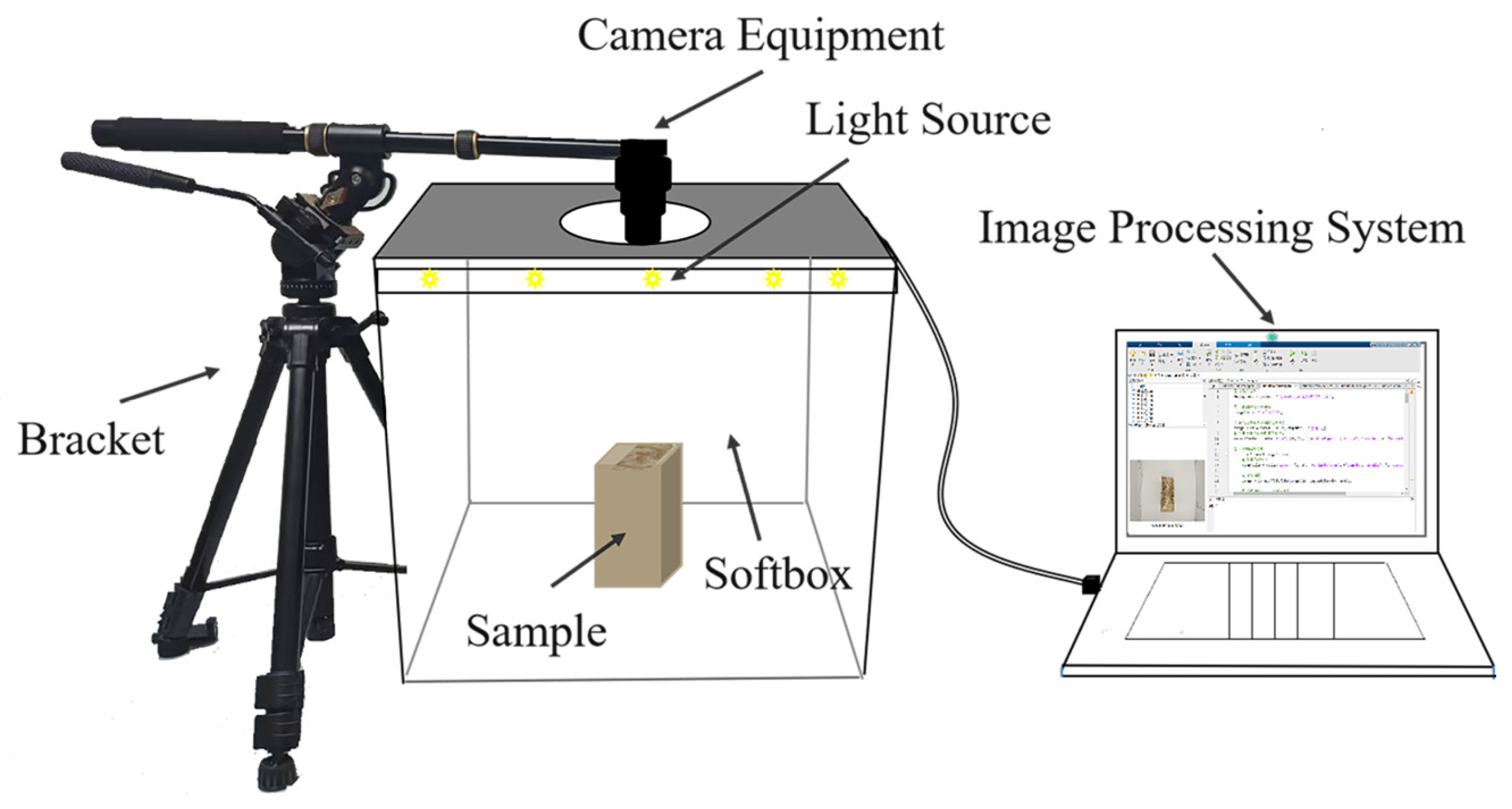

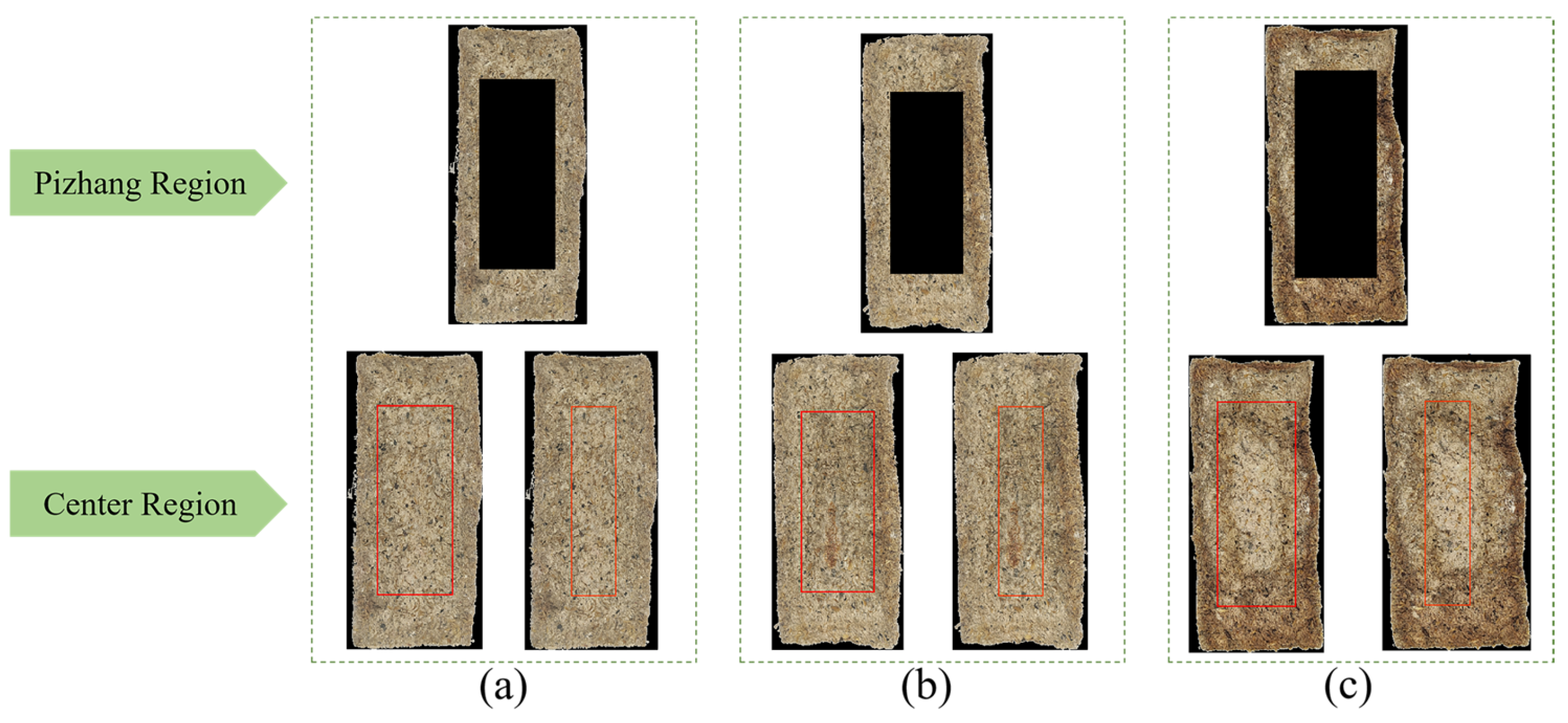
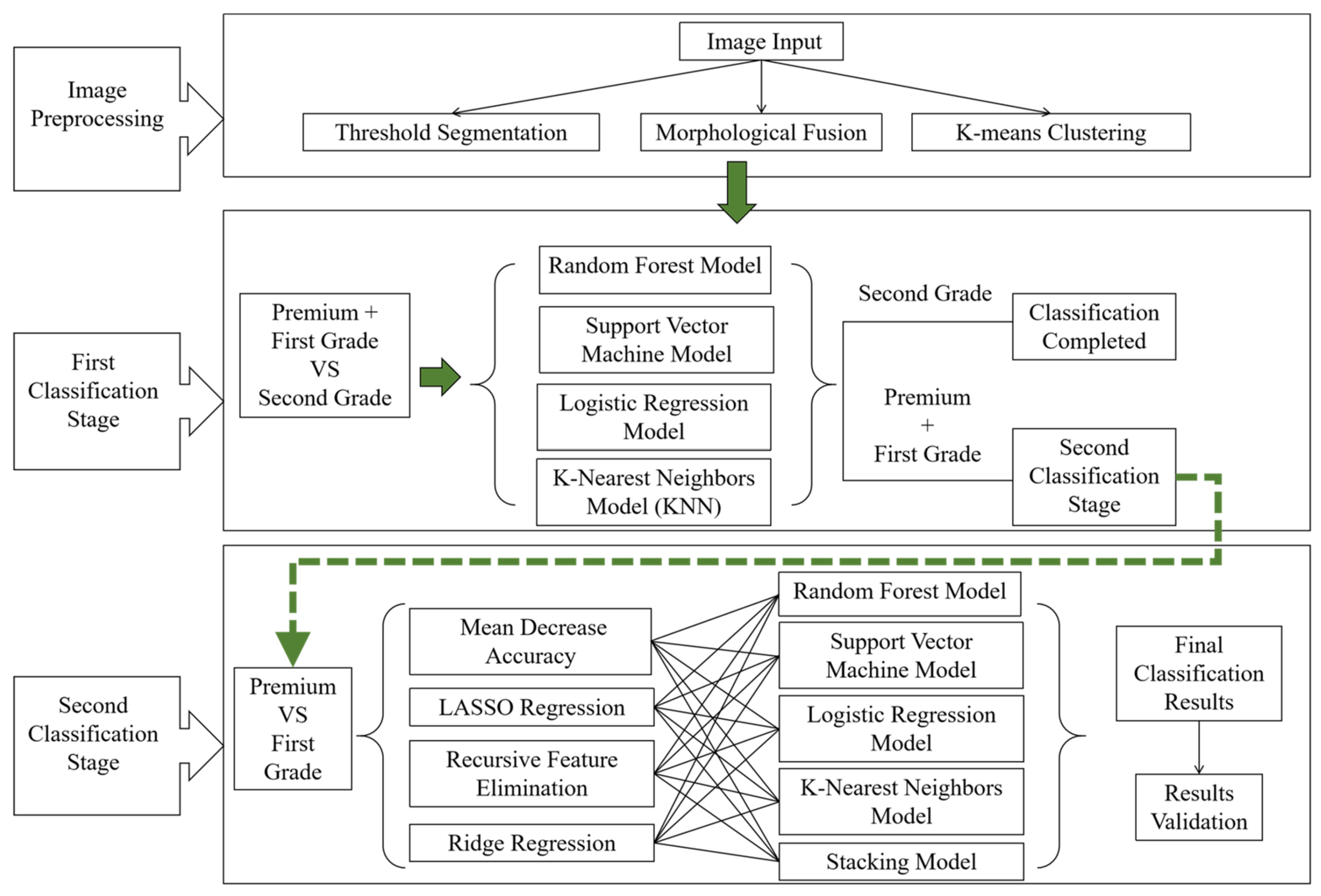

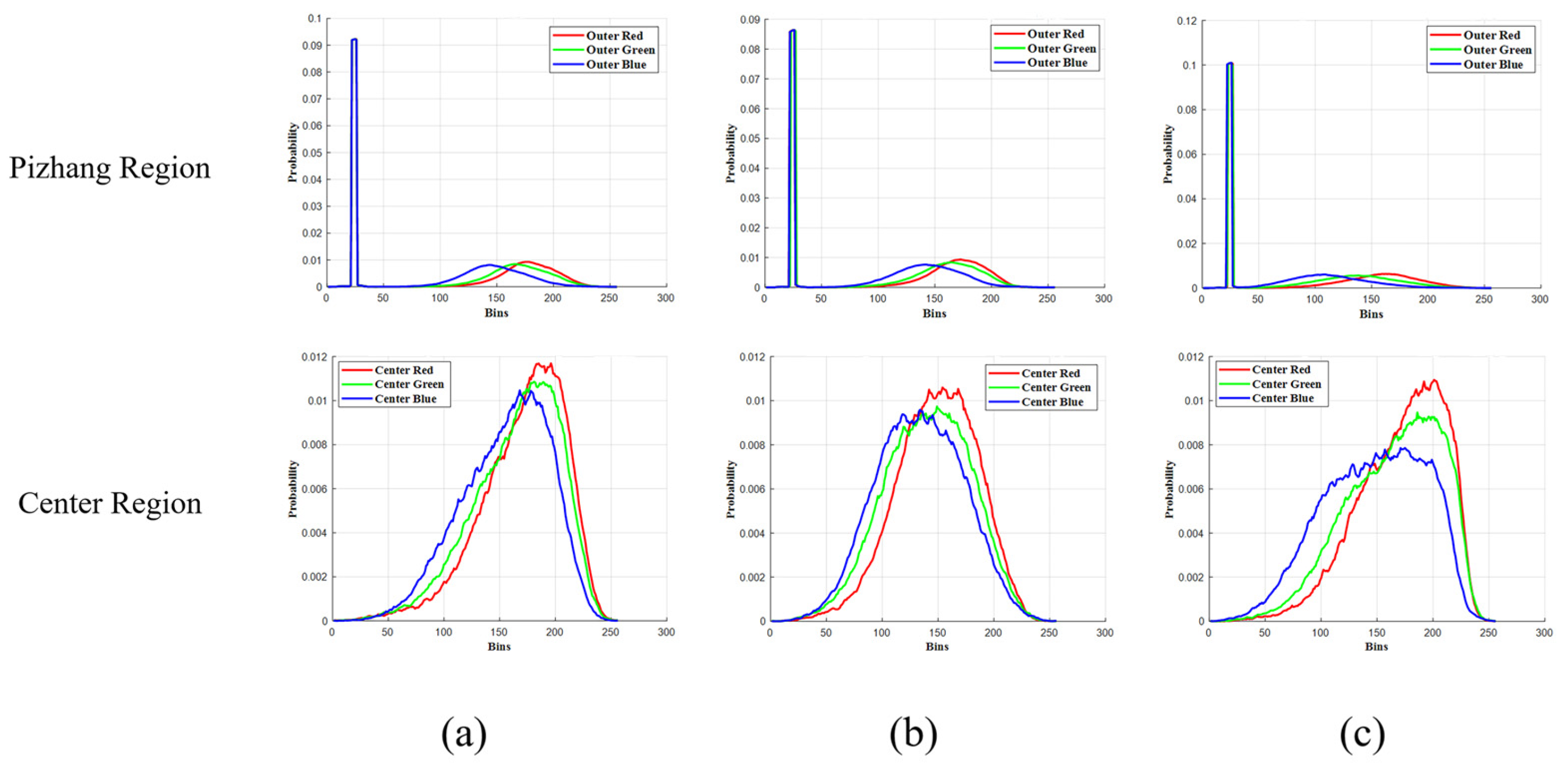

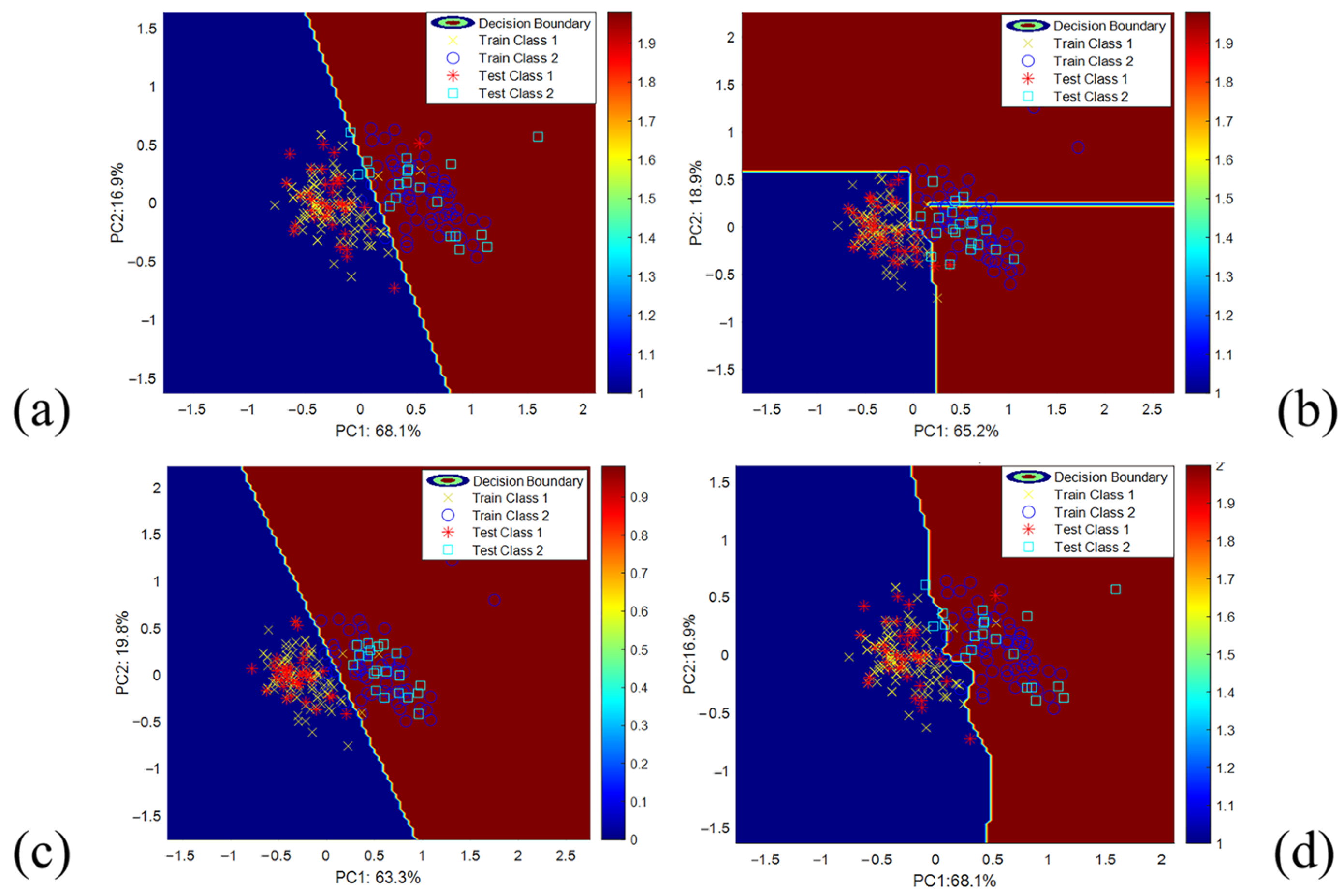
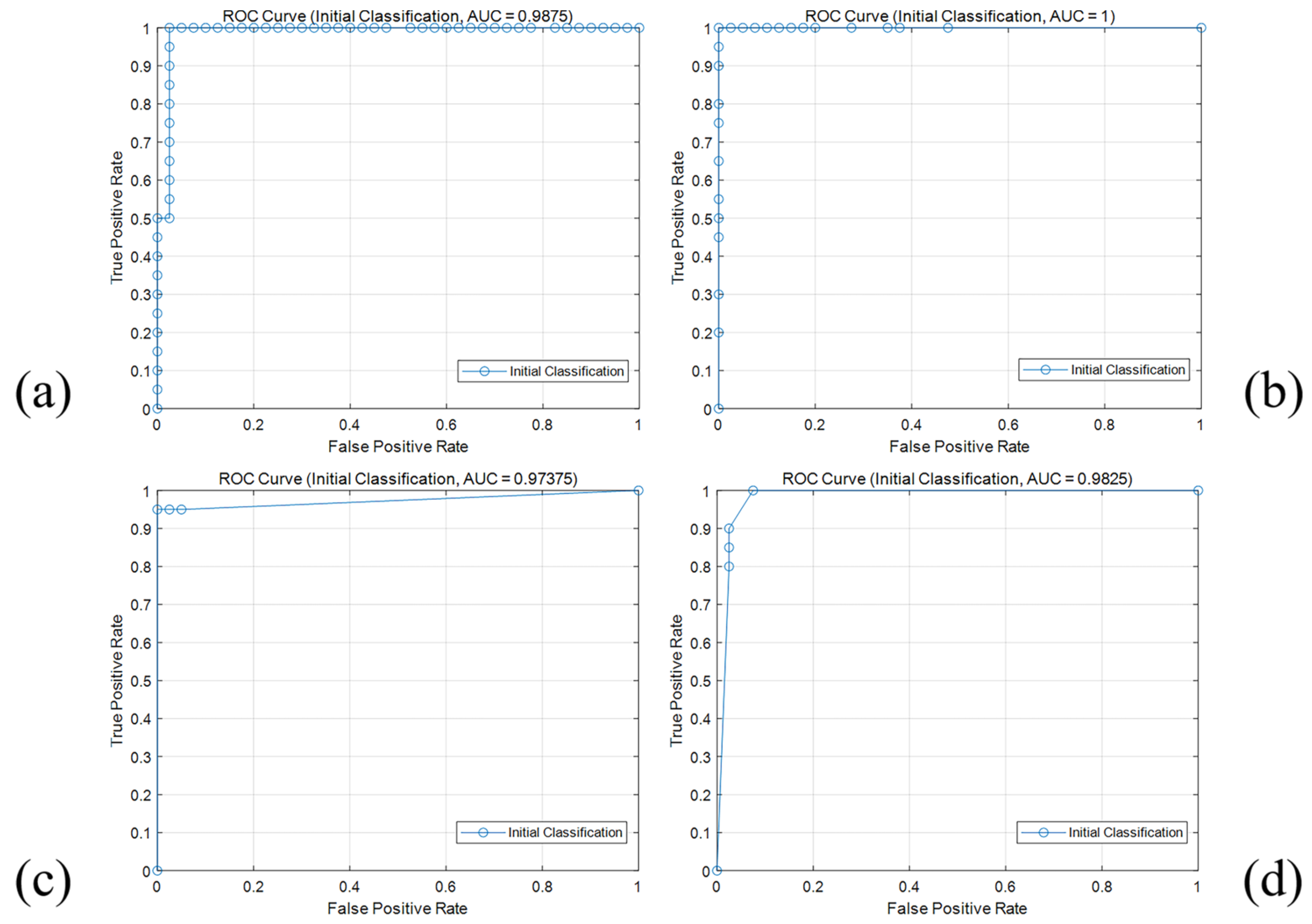
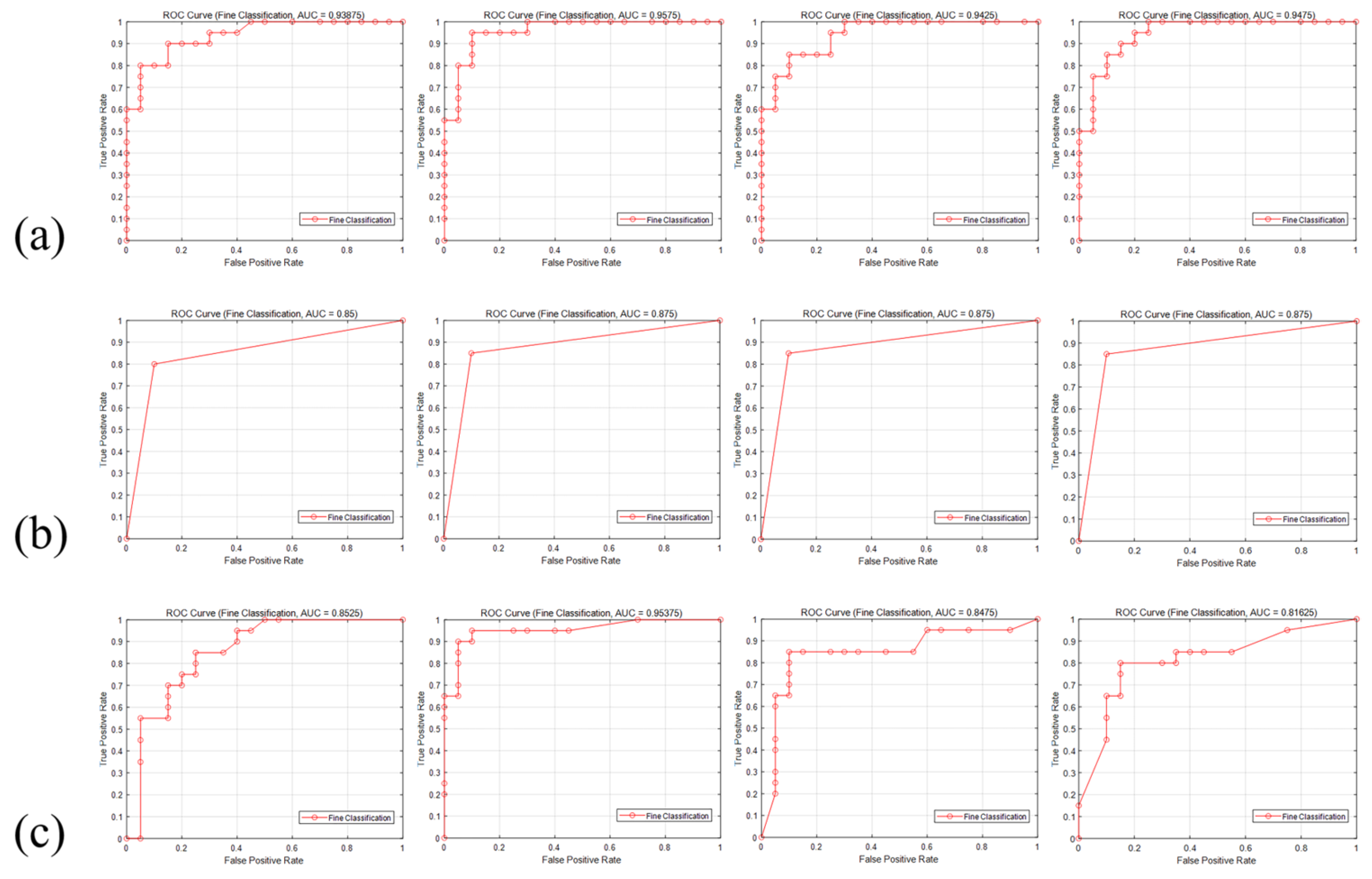
| Classification Steps | Factor Type | Factor Name | Quantity (Count) | Total (Count) |
|---|---|---|---|---|
| First layer classification | RGB | MeanRed, MeanGreen, MeanBlue, StdRed, StdGreen, StdBlue | 6 | 14 |
| HSV | MeanHue, MeanSaturation, MeanValue, StdHue, StdSaturation, StdValue | 6 | ||
| Pixel | RectArea, DarkArea | 2 | ||
| Second layer classification | RGB | MeanRed, MeanGreen, MeanBlue, StdRed, StdGreen, StdBlue | 6 | 38 |
| HSV | MeanHue, MeanSaturation, MeanValue, StdHue, StdSaturation, StdValue | 6 | ||
| Pixel | RectArea, DarkArea | 2 | ||
| RGB Color Histogram (2 ROIs) | Red_Bin1, Red_Bin2, Red_Bin3, Red_Bin4, Green_Bin1, Green_Bin2, Green_Bin3, Green_Bin4, Blue_Bin1, Blue_Bin2, Blue_Bin3, Blue_Bin4 | 24 |
| Method | Accuracy (%) | Precision (%) | Recall (%) | F1 Score | AUC | Image Processing Time (s) |
|---|---|---|---|---|---|---|
| Threshold Segmentation | 88.33 | 80.95 | 85.00 | 0.83 | 0.96 | 103.29 |
| K-means Clustering | 53.33 | 40.48 | 85.00 | 0.55 | 0.65 | 401.11 |
| Morphological Fusion | 96.67 | 95.00 | 95.00 | 0.95 | 0.96 | 130.78 |
| Model | Accuracy (%) | Precision (%) | Recall (%) | F1 Score | AUC | Runtime (s) |
|---|---|---|---|---|---|---|
| SVM | 96.67 | 97.50 | 97.50 | 0.97 | 0.98 | 0.15 |
| RF | 96.67 | 97.50 | 97.50 | 0.97 | 0.99 | 3.80 |
| LR | 96.67 | 95.00 | 95.00 | 0.95 | 0.96 | 0.33 |
| KNN | 95.00 | 95.12 | 97.50 | 0.96 | 0.98 | 0.45 |
| Feature Area | RFE | LASSO Regression | RF-MDA | Ridge Regression | ||||
|---|---|---|---|---|---|---|---|---|
| Factor Number | Importance Score | Factor Number | Importance Score | Factor Number | Importance Score | Factor Number | Importance Score | |
| Center | 1 | - | 1 | 0.0019 | 1 | 0.5901 | 1 | 0.2025 |
| 2 | - | 2 | - | 2 | 0.5499 | 2 | 0.3675 | |
| 3 | - | 3 | - | 3 | 0.4303 | 3 | 0.1097 | |
| 4 | 0.3575 | 4 | 0.0224 | 4 | 0.4270 | 4 | - | |
| 5 | - | 5 | 0.2149 | 5 | 0.4723 | 5 | - | |
| 6 | - | 6 | - | 6 | - | 6 | 0.2165 | |
| 7 | 0.2117 | 7 | 0.1480 | 7 | - | 7 | 0.1875 | |
| 8 | - | 8 | 0.2509 | 8 | 1.0250 | 8 | 0.3576 | |
| 9 | - | 9 | 0.2171 | 9 | 9 | 0.1930 | ||
| 10 | - | 10 | 0.0035 | 10 | 0.4881 | 10 | 0.2027 | |
| 11 | 0.0845 | 11 | 11 | 0.5443 | 11 | - | ||
| 12 | 0.1368 | 12 | 0.2075 | 12 | 0.4144 | 12 | 0.3603 | |
| 13 | - | 13 | 0.1189 | 13 | - | 13 | 0.1080 | |
| 15 | - | 15 | - | 15 | - | 15 | - | |
| 16 | 0.2285 | 16 | - | 16 | - | 16 | 0.1120 | |
| 17 | 0.2919 | 17 | 0.1105 | 17 | 0.5430 | 17 | 0.4287 | |
| 18 | 0.1256 | 18 | - | 18 | - | 18 | - | |
| 19 | - | 19 | - | 19 | - | 19 | - | |
| 20 | 0.1624 | 20 | - | 20 | - | 20 | 0.1395 | |
| 21 | 0.0389 | 21 | - | 21 | 0.5716 | 21 | - | |
| 22 | 0.1227 | 22 | - | 22 | 0.5321 | 22 | 0.1637 | |
| 23 | - | 23 | - | 23 | - | 23 | - | |
| 24 | 0.3772 | 24 | 0.1008 | 24 | 0.5370 | 24 | 0.2610 | |
| 25 | 0.3365 | 25 | 0.0642 | 25 | - | 25 | 0.2377 | |
| 26 | 0.3089 | 26 | 26 | - | 26 | 0.1806 | ||
| Pizhang | 14 | - | 14 | 0.3452 | 14 | - | 14 | - |
| 27 | 0.4121 | 27 | 0.3395 | 27 | - | 27 | 0.4351 | |
| 28 | - | 28 | 0.0670 | 28 | 0.4175 | 28 | 0.1119 | |
| 29 | 0.1381 | 29 | - | 29 | - | 29 | - | |
| 30 | - | 30 | 0.1281 | 30 | - | 30 | - | |
| 31 | - | 31 | - | 31 | - | 31 | - | |
| 32 | 0.0201 | 32 | - | 32 | - | 32 | - | |
| 33 | - | 33 | 0.0253 | 33 | - | 33 | - | |
| 34 | - | 34 | - | 34 | 0.4150 | 34 | - | |
| 35 | 0.0116 | 35 | 0.0488 | 35 | - | 35 | - | |
| 36 | 0.0178 | 36 | 0.0443 | 36 | - | 36 | - | |
| 37 | 0.0526 | 37 | 0.0336 | 37 | - | 37 | - | |
| 38 | 0.0163 | 38 | - | 38 | 0.4148 | 38 | ||
| Total | 20 | 20 | 16 | 19 | ||||
| Model | RF-MDA (%) | RFE (%) | LASSO Regression (%) | Ridge Regression (%) | Runtime (s) |
|---|---|---|---|---|---|
| SVM | 70.00 | 82.50 | 77.50 | 80.00 | 0.09 |
| RF | 87.50 | 82.50 | 85.00 | 87.50 | 1.28 |
| LR | 72.50 | 80.00 | 85.00 | 85.00 | 4.12 |
| KNN | 70.00 | 77.50 | 80.00 | 80.00 | 0.29 |
| S-LR | 87.50 | 85.00 | 87.50 | 87.50 | 2.83 |
| S-RF | 90.00 | 80.00 | 87.50 | 82.50 | 2.49 |
| Method | Model | Precision (%) | Recall (%) | F1 Score | AUC |
|---|---|---|---|---|---|
| RF-MDA | RF | 89.47 | 85.00 | 0.87 | 0.95 |
| S-LR | 89.47 | 85.00 | 0.87 | 0.87 | |
| S-RF | 94.44 | 85.00 | 0.89 | 0.95 | |
| RFE | RF | 84.21 | 80.00 | 0.82 | 0.93 |
| S-LR | 88.89 | 80.00 | 0.84 | 0.85 | |
| S-RF | 77.27 | 85.00 | 0.81 | 0.85 | |
| LASSO Regression | RF | 85.00 | 85.00 | 0.85 | 0.94 |
| S-LR | 89.47 | 85.00 | 0.87 | 0.87 | |
| S-RF | 89.47 | 85.00 | 0.87 | 0.84 | |
| Ridge Regression | RF | 89.47 | 85.00 | 0.87 | 0.94 |
| S-LR | 94.12 | 80.00 | 0.86 | 0.87 | |
| S-RF | 84.21 | 80.00 | 0.82 | 0.81 |
| Model | First Layer Classification Stage | Second Layer Classification Stage | |||
|---|---|---|---|---|---|
| Feature Selection Methods | |||||
| RF-MDA(%) | RFE(%) | LASSO Regression (%) | Ridge Regression (%) | ||
| (a) HH | |||||
| SVM | 91.75 | 85.00 | 82.50 | 83.33 | 75.00 |
| RF | 92.78 | 68.00 | 80.00 | 86.67 | 76.67 |
| LR | 93.81 | 83.33 | 81.67 | 86.67 | 80.00 |
| KNN | 95.56 | 76.67 | 71.67 | 75.00 | 76.67 |
| S-LR | - | 78.33 | 73.33 | 76.67 | 70.00 |
| S-RF | - | 81.67 | 78.33 | 80.00 | 77.78 |
| (b) HX | |||||
| SVM | 92.22 | 68.00 | 70.00 | 68.00 | 63.00 |
| RF | 90.00 | 83.33 | 80.00 | 81.67 | 85.00 |
| LR | 86.00 | 83.33 | 83.33 | 81.00 | 81.67 |
| KNN | 86.00 | 70.00 | 68.00 | 69.00 | 75.00 |
| S-LR | - | 75.00 | 76.00 | 72.00 | 75.00 |
| S-RF | - | 75.00 | 76.00 | 73.00 | 74.00 |
Disclaimer/Publisher’s Note: The statements, opinions and data contained in all publications are solely those of the individual author(s) and contributor(s) and not of MDPI and/or the editor(s). MDPI and/or the editor(s) disclaim responsibility for any injury to people or property resulting from any ideas, methods, instructions or products referred to in the content. |
© 2025 by the authors. Licensee MDPI, Basel, Switzerland. This article is an open access article distributed under the terms and conditions of the Creative Commons Attribution (CC BY) license (https://creativecommons.org/licenses/by/4.0/).
Share and Cite
Zhao, M.; Han, C.; Xue, T.; Ren, C.; Nie, X.; Jing, X.; Hao, H.; Liu, Q.; Jia, L. Establishment of a Daqu Grade Classification Model Based on Computer Vision and Machine Learning. Foods 2025, 14, 668. https://doi.org/10.3390/foods14040668
Zhao M, Han C, Xue T, Ren C, Nie X, Jing X, Hao H, Liu Q, Jia L. Establishment of a Daqu Grade Classification Model Based on Computer Vision and Machine Learning. Foods. 2025; 14(4):668. https://doi.org/10.3390/foods14040668
Chicago/Turabian StyleZhao, Mengke, Chaoyue Han, Tinghui Xue, Chao Ren, Xiao Nie, Xu Jing, Haiyong Hao, Qifang Liu, and Liyan Jia. 2025. "Establishment of a Daqu Grade Classification Model Based on Computer Vision and Machine Learning" Foods 14, no. 4: 668. https://doi.org/10.3390/foods14040668
APA StyleZhao, M., Han, C., Xue, T., Ren, C., Nie, X., Jing, X., Hao, H., Liu, Q., & Jia, L. (2025). Establishment of a Daqu Grade Classification Model Based on Computer Vision and Machine Learning. Foods, 14(4), 668. https://doi.org/10.3390/foods14040668







